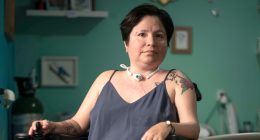The actress and entrepreneur has learned that to be successful, the message is as important as the product.
March 3, 2020 15+ min read
This story appears in the March 2020 issue of Entrepreneur. Subscribe »
“These shoes are going to kill me,” Tracee Ellis Ross calls out to the costume designer, as she holds up a pair of Pradas.
Ross and the crew are on the Disney lot in Burbank, Calif., deciding on outfits for the next episode of Black-ish, in which she plays the lead. The fitting department is a cramped, cluttered space in one of the soundstages, hemmed in by racks of clothes hung atop each other, bunk-bed-style, almost up to the ceiling — silky blouses, flared pants, dresses, heels, sneakers. (They snagged the Pradas on sale.) Everywhere you look, boards are tacked up with photos of the cast and set, scene breakdowns, press clippings, and sayings like “Behind every successful woman is a tribe of other successful women who have her back.”
Michelle Cole, the costume designer, has Ross’s back (and front). Rainbow “Bow” Johnson, M.D., the actress’s character, rarely wears the same thing twice — except for the shoes, because they’re usually out of the shot. Still, Ross is down for the Pradas. “I feel I would suffer for them,” she says.
“OK, and you’re able to walk?” Cole asks through the muffle of fabric.
“No,” says Ross. “I’m not able to walk in them. But I don’t really seem to care.”
That answer, in a way, is the rallying cry of an entrepreneur: This may not work — let’s do it anyway! It is also a good summary of Ross’s approach to life. Over and over again, she has stepped out without quite knowing how she’ll stay upright. Clearly, she’s done it in her Golden Globe–winning entertainment career, where she’s become known for a comic talent that curls and coils and pongs out of bounds, not unlike her signature galaxy of gravity-defying hair.
Related: Get to Know the Female Entrepreneurs Who Are Reshaping the Business World
But the same attitude has also led her to found and run a new company. It’s called Pattern, and it’s a line of products that’s as much about enhancing women’s natural, curly, coily, tight-textured hair as it is about restyling the way the culture sees those women. “Figuring out how to take an idea and pull it up into the atmosphere and into the third dimension? There’s just no road map,” she says. “I really had no idea how you turn a dream into goop. And I don’t mean Gwyneth Paltrow Goop. I mean hair products. Like, how do you do that?”
It took her 10 years. She laughs. Because really, nobody starts out knowing how to do that. You just put on the new shoes and walk.

Image Credit: Emily Shur
We duck into Ross’s “rainbow” trailer. It must be 85 degrees in here. She likes it hot. There’s a vague sagy-musky incense she can’t identify, which is out of character for a woman who’s surgically specific about what she likes and doesn’t. At 47 — and she will tell you her age within a minute of meeting you — Ross is riding high. She’s busting out of her sitcom success, which took flight in 2000 on Girlfriends and continues into her sixth season of Black-ish, a show that has gained critical acclaim for tackling issues like police brutality and slavery. Later this year, she’ll costar in the film Covers with Dakota Johnson and provide the lead character’s voice in the animated series Jodie, an MTV Daria spin-off, which Ross is also executive producing — part of venturing behind the camera to take a bigger role in the storytelling. That includes creating and executive producing the series Mixed-ish, a Black-ish prequel about Rainbow as a young girl, which premiered last fall.
Like Bow, Ross has a white father, Robert Ellis Silberstein, and a black mother, Diana Ross. And for those who don’t know, yes, that Diana Ross, the icon. “I talk to my mom a lot,” she says. “I don’t know what we talk about, but we talk a lot. If I call her at 5:30, she’s usually up. She never not answers the phone for her kids.” No doubt, Ross had quite a start. The middle sister of five siblings, she grew up between the States and Europe, and went to college at Brown University, where she discovered acting. Although she had all kinds of dreams, never did she think of becoming an entrepreneur.
“I don’t know that I even knew the word or what it meant,” she says. “But I feel like my childhood trained me to be a producer and a CEO. My mom is not a woman who sat somewhere and people did things. She is an extremely professional woman who has a sense of agency in her own life and a real work ethic — along with making dinner and waking us up for school and being glamorous, gorgeous, joyful, fun. So it just gave me that example.”
Looking back, Ross realizes that her journey to entrepreneurship started young — when she was a teenager doing R&D on herself. She’d quit using relaxers to chemically straighten her hair, but she couldn’t find products for wearing it natural. “I literally started buying everything,” she says, “to the point that my mother was like, ‘Listen here, little girl, your hair products alone are going to break the bank. You need to get either a really good job or a really rich husband if this is going to keep happening.’ ”
Related: These City Programs Are Giving Minority-and Women-Owned Businesses Access to Capital
Like so many women with curly or tight-textured hair, she experimented. Beer and Keri lotion worked, but not for long. Deep-conditioning products seemed to help…somewhat. She constantly tinkered in the shower and kept it up into adulthood.
By 2008, she was starring in the last season of Girlfriends and still her own hair chemist. One day, she stopped at a beauty supply store on Wilshire Boulevard in L.A., and a guy came out of the salon in the back. “You have no idea,” she remembers him saying, “the amount of women that come in with a picture of you pulled out of a magazine saying they want your hair. If you had hair products, you would be a millionaire.’ ”
Hmm, she thought, walking out, could I make hair products? That’s so interesting. Hair might seem like a shallow or purely aesthetic subject, but for black and brown women who wear their hair natural to express their authentic selves, it is a political statement. Ross could talk for days about the connection between her own hair and self-acceptance. But the notion that there was a business opportunity around helping all the other women struggling like her — that never occurred to her until that man dropped the idea.
She started thinking about the marketplace. Only a few products existed for black women’s natural hair, and they didn’t work for her. There was a void, and a customer base that needed no convincing. “We’re going to keep showering — I mean, I hope so,” she says. “We could probably stand to use less water — no, not probably, absolutely—but washing your hair is not going anywhere. And you don’t need to do a con job [on customers]: ‘You’re so ugly, you need this.’ Like, no! ‘You’re gorgeous. Do you want stuff to support your gorgeousness?’ That’s it to me.”
Her company of hair products flashed before her.

Image Credit: Emily Shur
Once Girlfriends finished in 2008, Ross sat at her computer and wrote a hair care brand pitch for curly, coily, and tight-textured hair. The vision was twofold: The company would create great products for this community “but also flip on its head the way we are seen and marketed to, so it’s not based on a beauty industry that just doesn’t see us,” she says. “I say ‘the beauty industry,’ but honestly, it’s the world.”
Being willing to define not only a new role for herself but the vision she could bring to the world is the kind of pivotal moment that makes an entrepreneur. But if she now saw herself as a brand builder, the people around her didn’t get it. “Why would anybody want hair products from you? You’re an actress,” someone at an agency she worked with said. Another suggested she make wigs. A third said to just do a hair TV show.
Ross didn’t want to pretzel herself into someone else’s idea and pressed forward with her own. She tried to launch her line with two large beauty companies (which she won’t name), but neither worked out. When JCPenney approached her about a limited edition fashion line, as much as she’d love to design clothes, she thought no; it would just be a distraction from her hair care mission. “And then I was like, “Hold on, everybody. Hold on, team. Hold on!” she says. “First of all, how much money can I get and how can that fund the hair company? And then, there were so many extremely important opportunities for growth and to learn how I, my brand, whatever you want to call it, translates monetarily, what works, what goes into articulating my taste, point of view, vision into an actual thing.”
So she went for it.
At the same time Ross worked on developing the collection, she was also starting to explore her personal narrative in a new way: What exactly was she to people? Who did she want to be? Circling those questions was deeply personal, but defining the answers is something every entrepreneur must do for herself. Ross had always seen herself as part of the larger history of black culture: “Our contribution and our ownership over what we create has become invisible because of the way the story is told,” she says. So\it was time to start telling hers — honestly and, just as important, unapologetically.
Related: Supermodel Karlie Kloss’s Lesson to Young Women: Never Be Afraid to Ask Questions!
She picked her moments. She gave a speech at a Glamour Women of the Year Summit in 2017, which she called “My Life Is Mine.” Why should she apologize for being single and childless at 45, she asked? And several months later, she started working on a talk, which she’d give at TED in 2018, called “A Woman’s Fury Holds Lifetimes of Wisdom.” “That fury,” she said, “sits deep inside us as we practice our smiles and try to be pleasant.” She spoke the words that women thought but didn’t say, which is why the videos just added to the millions of followers she’d been gathering on Instagram. Ross was becoming their voice.
And voice is indeed monetizable.
“As somebody who comes from the brand space,” says Rachel Jonas Gilman, who worked for Juicy Couture, Cole Haan, and Jonathan Adler, and would go on to become managing director of Pattern, “what gets you excited is when somebody is truly authentic. And that’s Tracee. It’s super rare. But it’s extremely important in this day and age, when there’s a lot of different brands and noise in the marketplace.”
Now it was time for Ross to become louder.

Image Credit: Emily Shur
The JCPenney collection did well, and Ross put the licensing fee she’d gotten into her nascent hair care brand. She hired a seasoned beauty industry expert, who didn’t pan out and was pretty disappointing. But in a way, Ross didn’t need her, having learned so many lessons herself about retail from doing the fashion line — the detail that goes into a hangtag, how photographer deals must include a budget for retouching, the importance of maintaining creative control (a big one), and, she says, “the shelves!” She needed to line up some shelves.
As Ross continued the push for her company based on sheer conviction, unlike just a few years ago, she now had a voice, a perspective, and some industry savvy. She approached Ulta Beauty about a retail deal, and this time someone got it. “What instantly struck me about Tracee was her passionate advocacy for inclusivity that comes through in everything she does,” says CEO Mary Dillon. Dave Kimbell, Ulta’s president, was in that meeting, too. Her celebrity was certainly a plus, he says, “but what’s unique about Tracee is [her] personal passion and authenticity” — that golden word again — “because she came at it from a place of sharing her own story, and she has a remarkable ability to connect with people. We were confident from day one that she would be successful.”
That was a turning point. After locking in an exclusive deal, it was time to turn her old pitch document into squeezable, pumpable, dollopable goop for 3B to 4C hair. (The numbers refer to the size and shape of different curl patterns.) Ross met with several chemists and chose a lab and manufacturer in L.A. so she could work in person with the team. She started with shampoos and conditioners, and tested every formula. As her dream literally started to gel, she also found an operational partner.
“I’ll just never forget sitting there and hearing Tracee speak,” says Shaun Neff, cofounder of Beach House Group, a company that incubates celebrity-driven brands, including Florence by Mills, created with Millie Bobby Brown, and Shay Mitchell’s Béis bags. Neff, too, was sold within the first 15 minutes of meeting. “Because we’re on the operator side, we needed to make sure to find a true business partner, not just a celebrity talent who will lend some photo shoots and social media power. So for me it was just like this angel fell out of the sky.”
Related: How a Great Idea and Just $500 Launched a Powerful Network of Entrepreneurial Women of Color
From there, Pattern was fully born. Ross was clear about keeping a majority stake and serving as CEO, and gave Gilman “a huge brand bible” of images, words, and ideas she’d collected. Then the two of them gathered at her house over many evenings, shaping every element of the brand.
One thing they knew: It would have to match the bold and honest voice Ross had defined. For the campaign photo, she decided to pose nude with the tagline “Sometimes it’s just all about the hair” circling her head. “I’ve never taken naked pictures,” she says, then, leaning conspiratorially, “I mean by a professional!” She chose a photographer named Micaiah Carter, whom she knew would capture her vision, without a hint of selling sex. “The image felt, honestly, really innocent and beautiful: Like, ‘Here I lay one of my deepest, most sacred dreams down before you. Here I lay me bare.’ ”
To get press — and this was a full-on Tracee idea — she invited 20 beauty editors to come watch her take a shower. She wanted them to see firsthand how she washed her hair with Pattern products (for this, she wore a bathing suit). “Looking for a bathroom big enough to fit that many people in New York City is not an easy task!” says Gilman, who several times declared she couldn’t pull it off. But Ross insisted. With the help of a real estate person, Gilman finally scored a shower space in Tribeca. On the day of the event, it was extremely hot, and there was no air conditioning. On top of that, the elevator broke, so everyone had to walk up five flights. “It was definitely steamy in there,” Gilman says, “but memorable — and it got amazing pickup.”
At 6:00 a.m. a few days later, on September 9, Gilman gathered the Pattern team around the table at Beach House Group to eat cereal and watch the site launch.
Within the first minute, they started screaming. Then yelling. High-fiving. Fist-pumping. It went on for hours. They FaceTimed Ross, who was at Disney shooting Black-ish. “I kept hearing the numbers and was like, ‘I have no idea what they mean. Is this good?’ ” she says.
It was more than good. By the end of the first day, seven of the 23 SKUs had sold out. By the end of the week, it was up to nine. Then on September 22, Pattern launched at Ulta’s 1,200 stores.
As if that weren’t enough, on September 24, the show Ross cocreated, Mixed-ish, premiered amid an explosion of billboards featuring an illustration of her hair, larger than life, so lush it was bursting with flowers. “I couldn’t have planned that, didn’t plan it,” says Ross. “It was just full-on synchronicity. But I believe that when things are in the zeitgeist, they’re in the zeitgeist.”

Image Credit: Emily Shur
On a recent afternoon this year, Ross holds a retreat for Pattern at a hotel in West Los Angeles. The lean team includes three full-time staff and a dozen part-timers she shares with Beach House Group, all but two of them women, and many, women of color. As she continues to build the company, Ross is determined that her team be diverse, not just regarding race but in every way possible — age, background, hair type — because that ensures against “the blind spots each of us inevitably has,” she says.
Today is a chance for everyone to get a full dose of Ross and her vision going forward. Since the launch, sales are almost double the initial predictions, according to Neff. On Ulta’s end, “we frankly couldn’t be happier with the reaction, particularly with the conditioners,” says Kimbell. (Ulta declined to share their numbers.) “We see a huge opportunity in continuing to build this brand.”
As other startups and larger beauty companies enter the “multicultural” hair category, Neff and Ross are confident that there is plenty of gap for Pattern to thrive in. “Nearly eight in 10 black consumers have chemically free hair and prefer product collections made for their specific texture, hair issues, and styling choices,” write the authors of a 2019 Mintel report, which predicts the natural black hair care market will grow 11 percent to nearly $2 billion by 2024. If some brands have started out in this market and then branched out to other demographics, Pattern will only lean in further. “There are so many products for other hair, like, so many,” says Ross. “The dreams I have for expanding what we’re doing right now — I mean, there’s so much to do in this market.”
Related: Michelle Pfeiffer’s Fragrance Brand Took 20 Years (and Plenty of Rejection) to Build
That, in fact, is partly what she called the retreat for: The launch was about what you can do in the shower; now she wants to focus on styling products. Ross ultimately dreams of Pattern becoming a full-fledged beauty company — but if there’s one lesson she’s learned, it’s that things take way longer than you think they should, and it’s not an indication that you’re doing something wrong. Patience and perseverance are as important as anything else.
After a long day at the retreat, the Pattern team sits on the floor in a circle, and someone puts a pillow in the middle that looks like a fire. They pretend to fake-warm their hands and roast s’mores, and everyone lets their wavy, curly, coily, textured hair down.
At one point, they start reminiscing about their most poignant moments since starting on this journey. Ross remembers when it all kicked in for her. “I started trying the samples,” she tells me later, “and the team congealed. And I was like, ‘Oh my God; this dream is becoming a real thing.’ And you could tell that we were trying to fly a plane that we were still building. But we were up in the air.”









